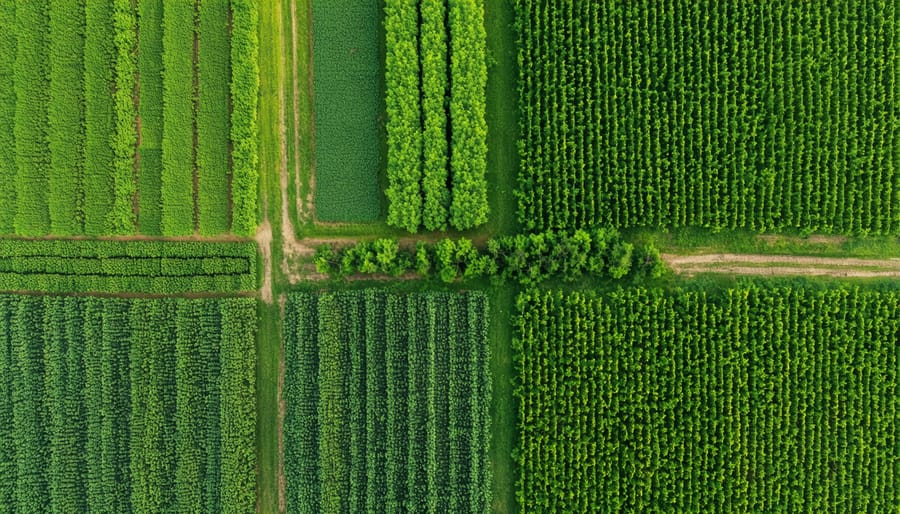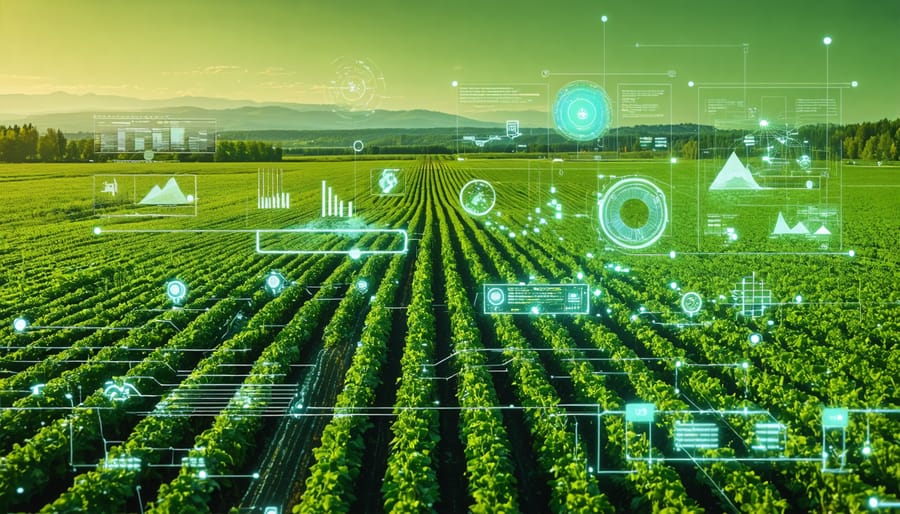Implement regenerative practices like cover cropping, crop rotation, and reduced tillage to build healthy soil that retains nutrients and moisture, reducing farm inputs and waste. Compost food scraps or process them through anaerobic digestion to create nutrient-rich soil amendments and biogas fuel from waste. Partner with food banks, shelters, and community organizations to donate excess fresh produce that would otherwise go to waste. Collaborate with other local farmers, food processors, restaurateurs and retailers to find synergistic opportunities to utilize each other’s waste streams as valuable inputs, closing resource loops.

The Circular Economy Opportunity
Economic Benefits
Implementing circular economy principles for food waste can yield significant economic benefits for Canadian farmers. By reducing waste, farmers can lower their expenses on inputs like water, fertilizer, and energy. Reusing byproducts such as animal feed or compost can further cut costs. Recycling food waste into value-added products presents new revenue opportunities. For example, an Alberta greenhouse operation saved $40,000 annually by converting plant waste into biomass fuel. A dairy farm boosted profits by $25,000 per year after installing an anaerobic digester to turn manure into electricity and bedding material.
Government grants and tax incentives are available to support circular economy initiatives. The Canadian Agricultural Partnership offers cost-sharing for projects that reduce waste and increase sustainability. By tracking and preventing food waste, farmers can also gain a competitive edge with eco-conscious consumers and access premium markets for sustainable products. Industry research suggests that for every $1 invested in food waste reduction, businesses can realize $14 in returns. Transitioning to a circular model not only benefits the planet but also the bottom line of Canadian agriculture.
Environmental Impact
Embracing circular practices in food production offers significant environmental benefits for Canadian farmers. By reducing food waste and repurposing organic materials, farmers can improve soil health, enhance nutrient cycling, and boost crop yields. Composting food scraps and agricultural by-products creates a valuable soil amendment that increases organic matter, improves soil structure, and supports beneficial microorganisms. This leads to healthier, more resilient soils that require fewer synthetic inputs.
Circular practices also help mitigate climate change by reducing greenhouse gas emissions associated with food waste decomposition in landfills. By keeping organic materials within the agricultural system, farmers can minimize their carbon footprint and contribute to a more sustainable future. Additionally, adopting circular principles often involves optimizing resource use, such as using renewable energy and conserving water, further enhancing the overall sustainability of farm operations.
As stewards of the land, Alberta farmers have a unique opportunity to lead the way in implementing circular economy strategies. By embracing these practices, they not only benefit the environment but also strengthen the long-term viability of their farms and contribute to a more resilient local food system. The transition to a circular economy requires innovation, collaboration, and a commitment to sustainable agriculture, but the rewards are well worth the effort.

Practical Strategies for Alberta Farms
Farm-Level Reduction
Reducing food waste at the farm level is a crucial first step in creating a more circular economy. By implementing best practices in harvesting, handling, and storage, Alberta farmers can minimize losses and ensure more of their hard work reaches consumers. Improved harvesting techniques, such as using gentler equipment and picking at optimal ripeness, can prevent bruising and damage that leads to waste. Proper handling, including careful sorting and grading, helps to identify and separate any suboptimal produce for alternative uses like animal feed or compost. Investing in modern storage facilities with precise temperature and humidity control can significantly extend the shelf life of crops, giving farmers more flexibility in their marketing and distribution. Additionally, exploring innovative solutions like on-farm processing and direct-to-consumer sales can create new revenue streams from produce that may not meet traditional market standards. By adopting these practices and staying open to new ideas, Canadian farmers can be leaders in the global effort to reduce food waste and build a more sustainable, circular food system.
Value-Added Processing
One exciting aspect of the circular economy approach is the opportunity to transform would-be waste into valuable new products. By thinking creatively, Alberta farmers can turn surplus or oddly-shaped produce into nutritious soups, sauces, or smoothie mixes. Spent grains from local breweries become tasty granola bars or high-fiber baked goods. Even farm by-products like corn stalks or fruit pomace have untapped potential as eco-friendly packaging materials or natural fabric dyes.
Animal feed is another avenue to keep nutrients cycling through the agricultural system. Vegetable trimmings, stale bread, and whey from cheese-making all make excellent fodder for pigs, poultry, and other livestock. What’s more, upcycling these scraps into feed reduces reliance on resource-intensive corn and soy, making the whole farm more resilient.
As you explore ways to add value to seconds and surplus, don’t be afraid to collaborate with other local producers, food entrepreneurs, and researchers. Innovation is a team sport, and together we can build a more circular, vibrant food economy for all Albertans. With a little ingenuity, the possibilities are endless – and delicious!

Collaborative Distribution
To reduce food waste and support local communities, Alberta farmers can engage in collaborative distribution by partnering with food banks, retailers, and processors. By donating excess fresh produce to food banks, farmers can ensure that nutritious food reaches those in need while minimizing waste. Collaborating with retailers to sell “imperfect” fruits and vegetables that may not meet standard aesthetic criteria but are still safe and delicious can also help reduce waste and provide affordable options for consumers.
Farmers can work with food processors to transform surplus crops into value-added products like soups, sauces, and preserves, extending shelf life and creating new revenue streams. Partnering with local schools, hospitals, and community organizations to provide fresh, locally-grown produce can foster strong connections and support public health.
To facilitate these partnerships, farmers can reach out to local food banks, retailers, and processors to discuss collaboration opportunities and logistical arrangements. Establishing clear communication channels, storage and transportation protocols, and quality control measures is key to success. By working together, Alberta’s agricultural community can build a more resilient, sustainable, and equitable food system that benefits everyone.
Support and Resources
Alberta farmers looking to adopt circular economy practices and reduce food waste have access to a wealth of support and resources. The Alberta government offers grants and funding programs specifically designed to help farmers implement sustainable agriculture initiatives. These include the Canadian Agricultural Partnership (CAP) program, which provides cost-sharing opportunities for projects that enhance environmental stewardship and reduce waste.
In addition to financial support, farmers can benefit from training programs and workshops offered by organizations like the Organic Agriculture Centre of Canada (OACC) and the Alberta Agriculture and Forestry Ministry. These programs cover topics such as composting, anaerobic digestion, and other circular economy strategies. They provide hands-on learning experiences and opportunities to connect with other farmers who are successfully implementing these practices.
Expert advice is also readily available to Alberta farmers. The province’s extensive network of agricultural extension agents and consultants can provide personalized guidance on reducing food waste and adopting circular economy principles. These experts can help farmers assess their current operations, identify opportunities for improvement, and develop tailored action plans.
It’s important to note that transitioning to a circular economy approach may require farmers to rethink some unsustainable farming practices and embrace new ways of doing things. However, with the right support and resources, Alberta farmers can successfully make this shift and reap the economic and environmental benefits of a more sustainable food system. By working together and leveraging the expertise and funding available, the Alberta agricultural community can lead the way in reducing food waste and building a thriving circular economy.
Conclusion
Embracing circular economy principles to reduce food waste presents a powerful opportunity for farmers to enhance profitability while contributing to a more sustainable future. By reimagining waste streams as valuable resources, agricultural operations can unlock new revenue streams, cut costs, and foster a more resilient local food system. The examples showcased in this article demonstrate the tangible benefits of adopting innovative waste reduction strategies, from creating nutrient-rich compost to generating renewable energy.
As stewards of the land, Canadian farmers are uniquely positioned to lead the charge in the circular economy revolution. By collaborating with fellow farmers, researchers, and industry partners, we can develop tailored solutions that optimize resource use and minimize waste. The journey towards a circular economy requires a shift in mindset, but the rewards – both financial and environmental – are well worth the effort.
The time to act is now. Let us seize this moment to build a more sustainable, profitable, and resilient agricultural sector. By embracing the principles of the circular economy, we can create a brighter future for our farms, our communities, and our planet. Together, we have the power to transform food waste from a challenge into an opportunity, one that nourishes both our soils and our bottom lines. So let us roll up our sleeves, get creative, and pave the way for a more circular, abundant tomorrow.











